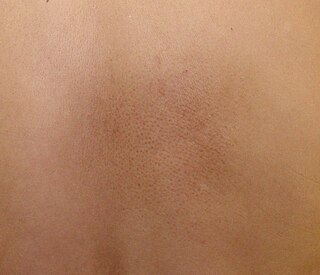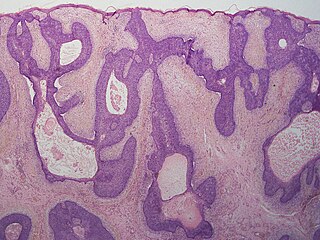
Macrocephaly is a condition in which the head is abnormally large; this includes the scalp, the cranial bone, and the contents of the cranium.

In medicine, a disease is considered asymptomatic if a patient is a carrier for a disease or infection but experiences no symptoms. A condition might be asymptomatic if it fails to show the noticeable symptoms with which it is usually associated. Asymptomatic infections are also called subclinical infections. Other diseases might be considered subclinical if they present some but not all of the symptoms required for a clinical diagnosis. The term clinically silent is also used.

A glomus tumor is a rare neoplasm arising from the glomus body and mainly found under the nail, on the fingertip or in the foot. They account for less than 2% of all soft tissue tumors. The majority of glomus tumors are benign, but they can also show malignant features. Glomus tumors were first described by Hoyer in 1877 while the first complete clinical description was given by Masson in 1924.

Hidradenoma refers to a benign adnexal tumor of the apical sweat gland. These are 1–3 cm translucent blue cystic nodules. It usually presents as a single, small skin-colored lesion, and is considered distinct from the closely related poroma. Hidradenomas are often sub-classified based on subtle histologic differences, for example:

Michelin tire baby syndrome, is characterized by multiple, symmetric, circular skin creases, or bands, on the forearms, lower legs, and often the neck that are present at birth. The creases disappear later in life. But it is a dangerous skin disease as it resides in the body rest of life, it can lead to death. They are reminiscent of those of Bibendum, the mascot of the tire manufacturer, Michelin, hence the name of the syndrome. Associated abnormalities vary and may include facial dysmorphism, upslanting palpebral fissures, hypertelorism, cleft palate, genital anomalies, mild developmental delay, ureterocele, smooth muscle hamartoma, nevus lipomatosus, Laron syndrome, and other defects.

Blue nevus is a type of melanocytic nevus. The blue colour is caused by the pigment being deeper in the skin than in ordinary nevi. In principle they are harmless but they can sometimes be mimicked by malignant lesions, i.e. some melanomas can look like a blue nevus.

Primary cutaneous amyloidosis is a form of amyloidosis associated with oncostatin M receptor. This type of amyloidosis has been divided into the following types:
Eccrine angiomatous hamartoma (EAH), first described by Lotzbeck in 1859, is a rare benign vascular hamartoma characterized histologically by a proliferation of eccrine and vascular components. EAH exists on a spectrum of cutaneous tumors that include eccrine nevus, mucinous eccrine nevus and EAH. Each diagnostic subtype is characterized by an increase in the number as well as size of mature eccrine glands or ducts, with EAH being distinguished by the added vascular component.
Fibrous hamartoma of infancy is a rapidly growing, painless, ill-defined subcutaneous or intradermal nodule that is generally solitary and less than 5 cm in size, though, rarely, multiple lesions occur synchronously.
Schöpf–Schulz–Passarge syndrome is an autosomal recessive condition with punctate symmetric palmoplantar keratoderma, with the keratoderma and fragility of the nails beginning around age 12. In addition to palmoplantar keratoderma, other symptoms include hypodontia, hypotrichosis, nail dystrophies, and eyelid cysts. Patients may also develop syringofibroadenoma and squamous cell carcinomas.
Eruptive vellus hair cysts are small lesions that occur most often in the chest wall, abdomen and extremities, often with a crusted surface. EVHC may occur randomly, or it can be inherited as an autosomal dominant trait. The condition affects males and females equally, and sporadic cases usually appear at 4–18 years of age. The cysts appear similar clinically to steatocystoma multiplex, as well as acneiform eruptions and milia. Therapeutic techniques that are safe and effective are rare, with incision and drainage being the primary form of treatment when sporadic regression does not occur.
Idiopathic scrotal calcinosis is a cutaneous condition characterized by calcification of the skin resulting from the deposition of calcium and phosphorus occurring on the scrotum. However, the levels of calcium and phosphate in the blood are normal. Idiopathic scrotal calcinosis typically affects young males, with an onset between adolescence and early adulthood. The scrotal calcinosis appears, without any symptoms, as yellowish nodules that range in size from 1 mm to several centimeters.

A sebaceous adenoma, a type of adenoma, a cutaneous condition characterized by a slow-growing tumor usually presenting as a pink, flesh-coloured, or yellow papule or nodule.
Primary cutaneous adenoid cystic carcinoma is a cutaneous condition characterized by a tumor that usually presents on the chest, scalp, or vulva of middle- to older-aged persons.

Pilomatricoma, also known as a calcifying epithelioma of Malherbe, Malherbe calcifying epithelioma, and Pilomatrixoma, is a benign skin tumor derived from the hair matrix. These neoplasms are relatively uncommon and typically occur on the scalp, face, and upper extremities. Clinically, pilomatricomas present as a subcutaneous nodule or cyst with unremarkable overlying epidermis that can range in size from 0.5-3.0 cm, but the largest reported case was 24 cm.
Pseudocyst of the auricle is a cutaneous condition characterized by a fluctuant, tense, noninflammatory swelling on the upper half of the ear.













